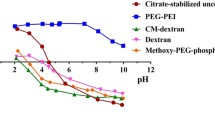Abstract
Magnetic nanoparticles (Fe3O4) were prepared by chemical precipitation method using Fe2+ and Fe3+ salts with sodium hydroxide in the nitrogen atmosphere. Fe3O4 nanoparticles were coated with human serum albumin (HSA) for magnetic resonance imaging as contrast agent. Characteristics of magnetic particles coated or uncoated were carried out using scanning electron microscopy and X-ray diffraction. Zeta potentials, package effects and distributions of colloid particles were measured to confirm the attachment of HSA on magnetic particles. Effects of Fe3O4 nanoparticles coated with HSA on magnetic resonance imaging were investigated with rats. The experimental results show that the adsorption of HSA on magnetic particles is very favorable to dispersing of magnetic Fe3O4 particles, while the sizes of Fe3O4 particles coated are related to the molar ratio of Fe3O4 to HSA. The diameters of the majority of particles coated are less than 100 nm. Fe3O4 nanoparticle coated with HSA has a good biocompatibility and low toxicity. This new contrast agent has some effects on the nuclear magnetic resonance imaging of liver and the lowest dosage is 20 µmol/kg for the demands of diagnosis.
Similar content being viewed by others
References
Liu C, Klemmer T J, Shukla N, et al. Oxidation of FePt nanoparticles[J]. J Magn Magn Mater, 2003, 266(1–2): 96–101.
Jeff W M B, Rodney A B, Bruce M M, et al. Relaxometry, magnetometry, and EPR evidence for three magnetic phases in the MR contrast agent MION – 46L [J]. J Magn Magn Mater, 1999, 194(1–3): 217–223.
Vander-Zaag P J, Noordermeer A, Johnson M T, et al. Coment on “size-dependent lurid temperature in nanoscale MnFe2O4 particles” [J]. Phys Rev Lett, 1992, 68(20): 3112.
Liu C, Zhang Z J. Sized-dependent superparamagnetic properties of Mn spinel ferrite nanoparticles synthesized from reverse micelles[J]. Chem Mater, 2001, 13(6): 2092–2096.
Cuyper M D, Joniau M. Magnetoproteoliposomes[J]. J Magn Magn Mater, 1993, 122(1–3): 340–342.
Lee S J, Jeong J R, Shin S C, et al. Nanoparticles of magnetic ferric oxides encapsulated with poly(D, L latide-co-glycolide) and their applications to magnetic resonance imaging contrast agent [J]. J Magn Magn Mater, 2004, 272–276(3): 2432–2433.
Knopp M V, Teng-Kobligk H V, Floemer F. Contrast agents for MRA: Future direction[J]. J Magn Reson Image, 1999, 10(3): 314–316.
Raj K, Moskowitz R. Commercial applications of ferrofluids[J]. J Magn Magn Mater, 1990, 85(1–3): 233–245.
Kim D K, Zhang Y, Kehr J, et al. Characterization and MRI study of surfactant-coated superparamagnetic nanoparticles administered into the rat brain[J]. J Magn Magn Mater, 2001, 225(1–2): 256–261.
Zavaljevski A, Holland S K, Dhawan A P, et al. Multilevel computed hemodynamic parameter maps from dynamic perfusion MRI[J]. IEEE Transactions, 1999, 48(3): 711–720.
Tiefenauer L X, Tschirky A, Kühne G, et al. In vivo evaluation of magnetite nanoparticles for use as a tumor contrast agent in MRI[J]. Magn Reson Imaging, 1996, 14(4): 391–402.
Babes L, Denizot B, Tanguy G, et al. Synthesis of iron oxide nanoparticles used as MRI contrast agents: a parametric study[J]. J Coll Inter Sci, 1999, 212(9): 474–482.
Lemoine D, Francois C, Kedzierewicz F, et al. Stability study of nanoparticles of poly(-caprolactone), poly(D,L-lactide) and poly(D,L-lactide-coglycolide) [J]. Biomaterials, 1996, 17(22): 2191–2197.
Peters T J. All about albumin biochemistry, genetics and medical applications[M]. San Diego: Academic Press, 1996.
Bendedouch D, Chen S H. Structure and interparticle interaction of bovine serum albumin in solution studied by small-angle neutron scattering [J]. J Phys Chem, 1983, 87(9): 1473–1477.
Zhou X Z, Caravan P, Clarkson R B, et al. On the philosophy of optimizing contrast agents. An analysis of 1H NMRD profiles and ESR lineshapes of the Gd (III) complex MS-325 + HSA[J]. J Magn Reson, 2004, 167(1): 147–160.
Tiffany S D, Elizabeth F M, Cynthia K L. Analysis of protein/ligand interactions with NMR diffusion measurements: the importance of eliminating the protein background[J]. J Magn Reson, 2002, 155(2): 217–225.
William H O, Cynthia K L. Improved Spin-echo-edited NMR diffusion measurements[J]. J Magn Reson, 2001, 153(2): 273–276.
Gianluigi V, Maurizio D, Maria R G, et al. 1H NMR studies on the interaction of β-carboline derivatives with human serum albumin [J]. J Magn Reson, 1998, 130(2): 281–286.
Zhang C F, Cao J Q, Yin D Z, et al. Preparation and radiolabeling of human serum albumin (HSA)-coated magnetite nanoparticles for magnetically targeted therapy[J]. Applied Radiation and Isotopes, 2004, 61(6): 1255–1259.
Roser M, Fischer D, Kissel T. Surface-modified biodegradable albumin nano- and microspheres. II: effect of surface charges on in vitro phagocytosis and biodistribution in rats[J]. European Journal of Pharmaceutics and Biopharmaceutics, 1998, 46(3): 255–263.
Masafumi H, Kiyotaka A, Naoki T. Catalytic activity and structural analysis of polymer-protected Au/Pd bimetallic clusters prepared by the successive reduction of HAuCl4 and PdCl2[J]. J Phys Chem, 1993, 97(19): 5103–5114.
Lazarides A A, Schatz G C. DNA-linked metal nanosphere materials: structural basis for the optical properties[J]. J Phys Chem B, 2000, 104(3): 460–467.
Author information
Authors and Affiliations
Corresponding author
Additional information
Foundation item: Project (2003AA305980) supported by the National High Technology Research and Development Program of China
Rights and permissions
About this article
Cite this article
He, Hw., Liu, Hj., Zhou, Kc. et al. Characteristics of magnetic Fe3O4 nanoparticles encapsulated with human serum albumin. J Cent. South Univ. Technol. 13, 6–11 (2006). https://doi.org/10.1007/s11771-006-0097-2
Received:
Accepted:
Published:
Issue Date:
DOI: https://doi.org/10.1007/s11771-006-0097-2
Key words
- Fe3O4 nanoparticle
- human serum albumin
- chemical precipitation method
- magnetic resonance imaging contrast agent




